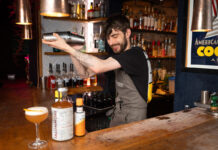Building the right range will ensure a serve to suit everyone, say drinks firms

A BROAD range of flavour profiles backed by solid staff training is key if operators are to make the most of malt whisky this festive season – and beyond.
That was the message from drinks firms contacted by SLTN, who said licensees with a thorough understanding of their whisky range – and their outlet’s clientele – stand to reap the rewards.
Ian Peart of Pernod Ricard, the firm behind Chivas Regal and The Glenlivet, said Scotch whisky “contains more flavour diversity than any other spirit”, potentially providing something for everyone.
“In order to capitalise on this opportunity, pubs must consider stocking varying styles of whisky in order to offer a taste for everyone, therefore appealing to a wider audience,” said Peart.
“Licensees can take a steer from broader trends to help inform their portfolio decisions – in particular the continued growth of premium spirits.
“As a result, there is a significant opportunity for licensees to drive profit margins by stocking a range of premium whiskies.”
To make the most of the variety available in the whisky category, Michelle Lansdowne of Burn Stewart Distillers, the firm behind Black Bottle, suggested operators take a step into the unknown.
“My advice would be to look at stocking a few niche brands in addition to mainstream ones,” said Lansdowne.
“Consumers are always looking to explore lesser-known brands and enjoy discovering new products.”
Jennifer Meenan, Auchentoshan brand manager at Morrison Bowmore, whose other whisky brands include Glen Garioch and Bowmore, agreed that a broad range of whiskies could attract a wide customer base, suggesting that such a range could open the category up to new drinkers.
“Engaging and educating a younger, discerning whisky drinker who is just starting their whisky journey with a single malt from each region will help them to broaden their knowledge and enjoyment of whiskies,” said Meenan.
Stocking a range is only half the battle for operators, however.
Look at stocking a few niche brands in addition to mainstream ones.
Meenan highlighted cocktails as a “key growth area” for whisky in the Scottish trade, attributing the trend to consumer demand as well as bartenders with a “desire to experiment”.
The growth in popularity of whisky cocktails was also highlighted by Roy Summers, on-trade sales director at First Drinks, whose brands include single malts Glenfiddich and The Balvenie.
“Cocktails are in year on year growth in the on-trade, and although other spirits categories are also driving this, malt whisky has seen uplifted sales as a result of it being promoted in cocktails in the past,” said Summers.
Jim Grierson, on-trade sales director at Maxxium UK, was another advocate of whisky cocktails.
However he also pointed to the importance of a well put together whisky menu to highlight the range.
And he advised operators to “make sure staff highlight the fact that there are new things to try”.
“Menus provide visibility and well-trained staff can share their passion and knowledge, providing consumer education and driving brand awareness,” said Grierson.
“A great atmosphere and quality of experience are still perceived by consumers as more important than price.
“This is best summed up as consumers wanting value for money.”
Neil Boyd, director of malts at Ian Macleod Distillers, whose whisky brands include Glengoyne and Tamdhu, said staff training is essential to help pub-goers navigate the whisky category.
“One obvious way [to boost sales] is to have your bar staff well trained, and that is something we do a lot of,” said Boyd.
“We do it in-bar and we do it at the distillery.
“People understand that the consumer wants to know why they should drink one brand over another.
“They expect bar staff in Scotland to understand the category.
“It’s important, if you want to be taken seriously, that your staff are well trained.”
It’s a view shared by Cara Laing of family-owned whisky firm Douglas Laing & Co.
“Whisky is so often all about recommendation, if staff are able to speak with some knowledge and enthusiasm it’s a massive advantage and can only help drive sales,” she said.
Training and product range aside, there are other steps publicans can take to help drive purchase of whiskies in their outlets.
“Operators should ensure whiskies are visible and easy for consumers to select from by creating a whisky section on the back bar and bringing it to life to give a disruptive effect which will engage consumers,” said a spokeswoman for Diageo, the firm behind whiskies such as Johnnie Walker, Lagavulin and Talisker.
Consumers expect bar staff in Scotland to understand the category.
“Staff should also be involved with this process by tasting and learning about each whisky category, so they can effectively sell the product to the consumer.
“Simple initiatives, like ‘malt of the week’ are proven category drivers.”
Laing was also supportive of promotional initiatives in the on-trade.
“A ‘malt of the month’ can help as it may entice you off your favourite brand and onto something else and who knows, you may like it,” said Laing.
Enticing new drinkers to the whisky category, and particularly to single malts, is a task that could also benefit from more teamwork between publicans and distilleries, said Margaret Mary Clarke, senior brand manager for Old Pulteney at Inver House Distillers.
“Sampling is key to attracting new consumers to the category as new consumers may not necessarily try single malts if they have to pay for it, therefore suppliers need to work with publicans to drive consumers to trial,” she said.



















